Liebherr HC1011, HC1060 User Manual
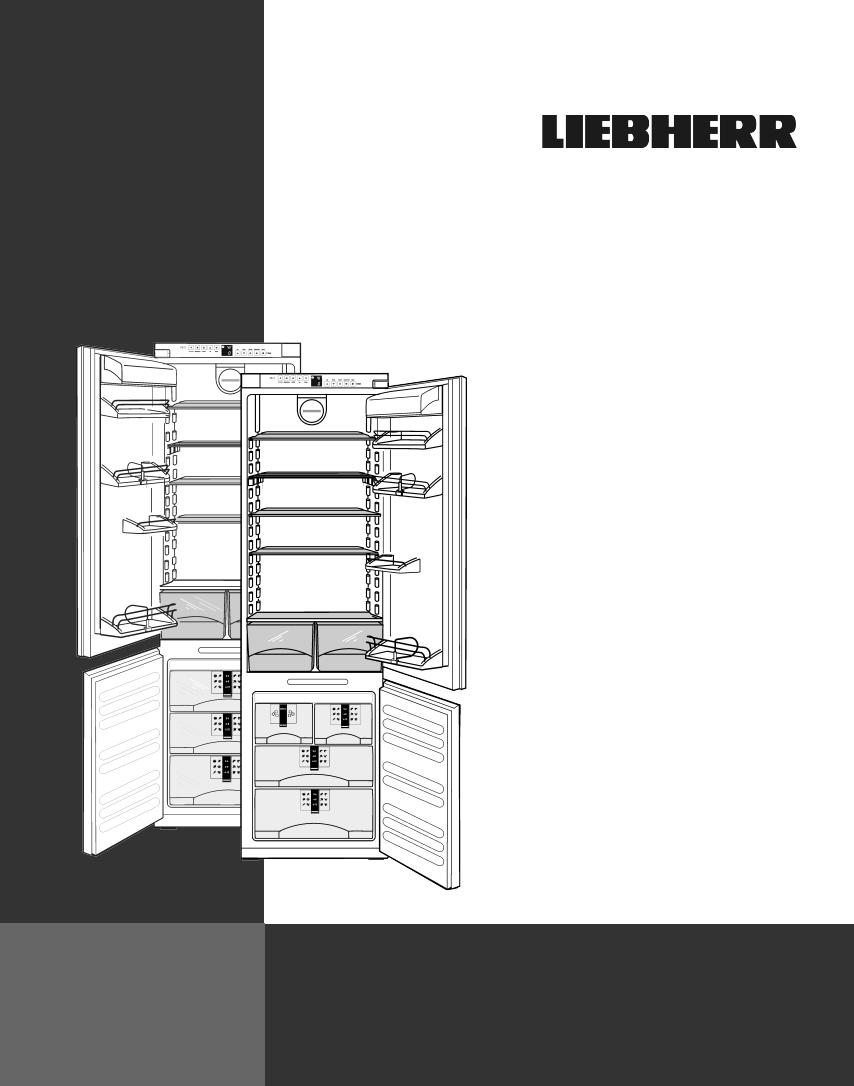
Use and Care Manual
Combined fridge-freezer for integrated use, door slider
Mode d'emploi
Combiné réfrigérateurcongélateur, intégrable, porte oscillante
Instrucciones de uso
Combinado frigorífico-congelador, integrable, puerta orientable
HC 1011/1060 HC 1001/1050 7082698 - 00

The appliance at a glance
Contents |
|
|
1 |
The appliance at a glance............................. |
2 |
1.1 |
Additional benefits............................................ |
2 |
1.2 |
Range of appliance use.................................... |
2 |
1.3 |
Conformity........................................................ |
3 |
1.4 |
Overview.......................................................... |
3 |
1.5 |
Net@Home....................................................... |
4 |
2 |
General safety information........................... |
4 |
3 |
Controls and displays................................... |
4 |
3.1 |
Operating and control elements....................... |
4 |
3.2 |
Temperature display........................................ |
4 |
4 |
Start-up........................................................... |
5 |
4.1 |
Transporting the appliance............................... |
5 |
4.2 |
Setting up the appliance................................... |
5 |
4.3 |
Disposal of packaging...................................... |
5 |
4.4 |
Connecting the appliance................................. |
6 |
4.5 |
Switching on the appliance............................... |
6 |
5 |
Operation........................................................ |
6 |
5.1 |
Energy saving.................................................. |
6 |
5.2 |
Temperature display unit.................................. |
6 |
5.3 |
Brightness of the temperature display.............. |
7 |
5.4 |
Child-proof lock................................................ |
7 |
5.5 |
Door alarm....................................................... |
7 |
5.6 |
Temperature alarm........................................... |
7 |
5.7 |
Fridge compartment......................................... |
7 |
5.8 |
Freezer compartment....................................... |
9 |
6 |
Maintenance................................................... |
11 |
6.1 |
Defrosting with NoFrost.................................... |
11 |
6.2 |
Cleaning the appliance..................................... |
11 |
6.3 |
Cleaning the IceMaker..................................... |
12 |
6.4 |
Replacing the interior light................................ |
12 |
6.5 |
Customer service............................................. |
12 |
6.6 |
Appliance Information...................................... |
13 |
7 |
Troubleshooting............................................ |
13 |
8 |
Putting appliance out of service.................. |
15 |
8.1 |
Vacation Tips................................................... |
15 |
8.2 |
Switching off the appliance............................... |
15 |
8.3 |
Decommissioning ............................................ |
16 |
9 |
Disposing of the appliance........................... |
16 |
10 |
Liebherr Warranty Plan................................. |
16 |
Congratulations on the purchase of your new appliance. With this purchase, you have chosen all the advantages of the latest refrigeration technology, guaranteeing you a highquality appliance with a long life span and high operating safety.
The equipment of your appliance gives you the highest level of day-to-day ease of operation.
Together we are making an active contribution to the conservation of our environment by purchasing this appliance which is manufactured in an environmentally friendly process with the use of recyclable materials.
We hope you enjoy your new appliance.
The manufacturer is constantly working to improve all models. Therefore please understand that we reserve the right to make design, equipment and technical modifications.
To get to know all the benefits of your new appliance, please read the information contained in these instructions carefully.
The instructions apply to several models, so there may be differences. Sections which only apply to certain appliances are indicated with an asterisk (*).
Instructions for action are marked with a  , the results of action are marked with a
, the results of action are marked with a  .
.
1 The appliance at a glance
1.1 Additional benefits
–CFC free
–Energy-optimized refrigerant circuit
–Energy-efficient insulation
–Low energy consumption
–User-friendly electronic controls
–Active function indicators
–Temperature can be controlled within climate rating range, regardless of room temperature. Temperature can also be displayed in degrees Fahrenheit or degrees Celsius. Choose the unit of temperature °F or °C.
–The appliance defrosts automatically - no need to spend time defrosting
–Variable and practical features
–Large refrigeration capacity
–Safety glass storage shelves
–Practical door arrangement for tall bottles
–Large freezing capacity
–Shelves can be removed to make space for large items.
–Freezer over-temperature alarm
–Quick-freeze feature for fresh food (SuperFrost)
–Power failure/“frost-control” display
–All freezer drawers suitable for quick-freeze
–Freezer compartment light
–Bright LED interior light*
–Door ajar alarm
–Handle grips on all extra-large drawers for easy transport
–Integrated transport grips on appliance housing
–Transport castors at back
–Easy to clean
–Door hinges can be reversed
–Door-on-door system for easy kitchen cabinet installation
–Soft stop mechanisms on both doors*
1.2 Range of appliance use
The appliance is designed for refrigerating food, for freezing and storing food and for making ice.
The appliance was designed for household use. It is not intended for commercial use, in particular it is not intended
2

The appliance at a glance
for laboratory purposes and the like. There is the danger of malfunctions.
The appliance is set to operate within specific ambient temperature limits according to its climate rating. The climate rating for your appliance is printed on the rating plate.
Note
u Compliance with the specified ambient temperatures is required, otherwise the refrigeration performance is reduced.
Climate rat- |
for ambient temperatures from |
||
ing |
|
|
|
SN |
50 |
°F (10 |
°C) to 90 °F (32 °C) |
N |
61 |
°F (16 |
°C) to 90 °F (32 °C) |
ST |
61 |
°F (16 |
°C) to 101 °F (38 °C) |
T |
61 |
°F (16 |
°C) to 110 °F (43 °C) |
1.3 Conformity
The refrigerant circuit has been tested for leaks. The appliance complies with the relevant safety regulations and the directives UL250 and CAN/CSA C22.2 #63.
1.4 Overview
(1) |
Operating and control |
Fig. 1 |
(10)Vegetable drawer |
||
(2) |
elements |
(11)Drain hole |
Butter and cheese |
||
(3) |
compartment |
(12)Rating plate |
Fan |
||
(4) |
Shelf, moveable |
(13)Freezer compartment |
(5) |
Storage rack for jars |
light |
(14)IceMaker* |
||
(6) |
Shelf, can be split |
(15)Info system |
(7) |
Interior light* |
(16)Freezer compartment |
(8) |
Door rack for tall bot- |
(17)VarioSpace |
(9) |
tles |
|
Coldest zone |
|
3
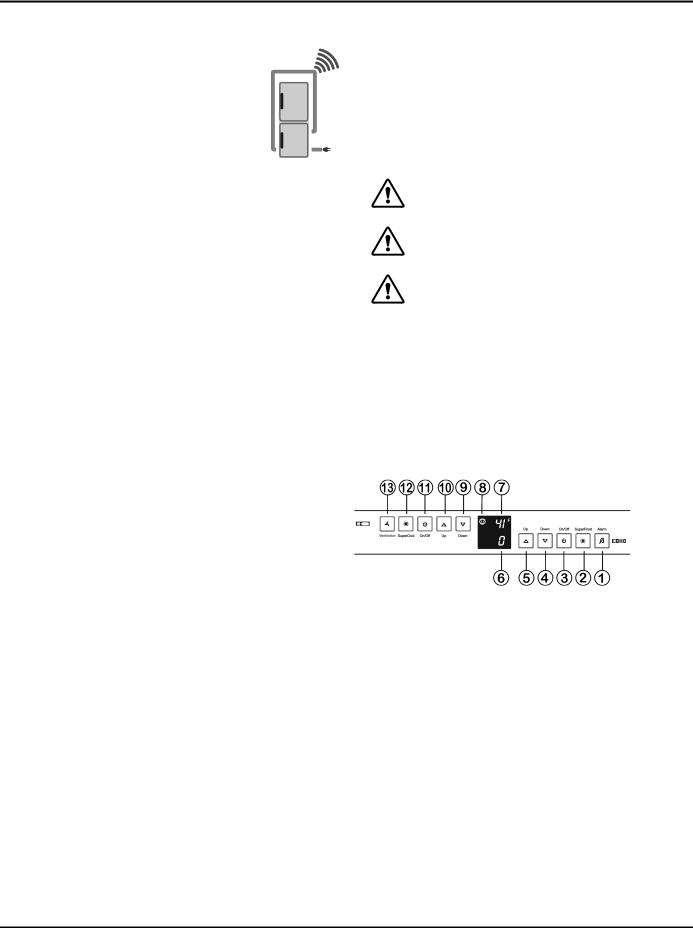
General safety information
1.5 Net@Home
Depending on the model and equipment, the appliance can be equipped with an additional connection for a retrofitted Net@Home module. You can connect a TeleSafe module or alternatively a home bus module. The modules are available from your specialized dealer.
The module may be connected by customer service personnel only for warranty reasons.
You will find more information on the Internet at www.liebherr.com.
2 General safety information
Read and follow these instructions. They contain safety advice which is important for safe and problem-free installation and operation. Always read and follow the safety advice.
Dangers for the user:
–This appliance is not designed for persons (or children) with physical, sensory or mental impairment or persons who do not have sufficient experience and knowledge, unless they have been instructed in the use of the appliance by a person who is responsible for their safety and supervised at first. Supervise children so that they do not play with the appliance.
–In the event of power failure, disconnect the power plug (do not pull on the power cord to do this) or switch off the fuse.
–Repairs, work on the appliance and replacement of the power cord should only be carried out by the customer service department.
–When disconnecting the appliance from the outlet, always take hold of the plug. Do not pull on the cable.
–The appliance should only be assembled and connected in accordance with the instructions.
–Please keep the instructions and pass them on to any new owner.
–All repairs to or work on the IceMaker must only be carried out by the customer service department or other specialist engineers trained to do this.*
–The manufacturer is not liable for damage arising from incorrect connection to the water supply.*
–Do not operate the appliance near explosive gases.
–Do not store explosive materials or spray cans with flammable propellants, such as e.g. butane, propane, pentane, etc. in the appliance. You can recognize such spray cans by the printed contents or a flame symbol. Any leaking gasses can be ignited by electrical components.
–High-proof alcohol should only be stored tightly sealed and standing upright. Any leaking alcohol could be ignited by electrical components.
Tipover hazard:
–Do not stand or climb on the plinth, drawers, doors, etc. This applies in particular to children.
–Do not use this appliance until it has been installed.
Risk of food poisoning:
–Do not consume food that has passed its best before date.
Danger of frostbite, feelings of numbness and pain:
–Avoid continued skin contact with the cold surfaces or chilled/frozen food or adopt protective measures, e. g. use gloves. Do not consume ice cream (especially sherbets) and ice cubes immediately when they are too cold.
Follow the specific instructions in the other sections:
|
DANGER |
indicates a hazardous situation, |
|
|
which if not avoided, will result in |
|
|
death or serious injury. |
|
WARNING |
indicates a hazardous situation, |
|
|
which if not avoided, could result in |
|
|
death or serious injury. |
|
CAUTION |
indicates a hazardous situation, |
|
|
which if not avoided, will result in mi- |
|
|
nor or moderate injury. |
|
NOTICE |
indicates a hazardous situation, |
|
|
which if not avoided, could result in |
|
|
damage to property. |
|
|
|
|
Note |
indicates useful advice and tips. |
3 Controls and displays
3.1 Operating and control elements
(1) |
Alarm button |
Fig. 2 |
(8) Child safety symbol |
||
(2) |
SuperFrost button |
(9) Fridge compartment |
(3) |
|
Down |
Freezer compartment (10)Fridge compartment Up |
||
(4) |
On/Off button |
(11)Fridge compartment |
Freezer compartment |
||
(5) |
Down button |
On/Off button |
Freezer compartment |
(12)SuperCool button |
|
(6) |
Up button |
(13)Ventilation button |
Freezer compartment |
||
(7) |
temperature display |
|
Fridge compartment |
|
|
|
temperature display |
|
3.2 Temperature display
The following is displayed in normal operation:
–the highest freezer temperature
–the average fridge compartment temperature The display is flashing:
–the temperature setting has been changed
4
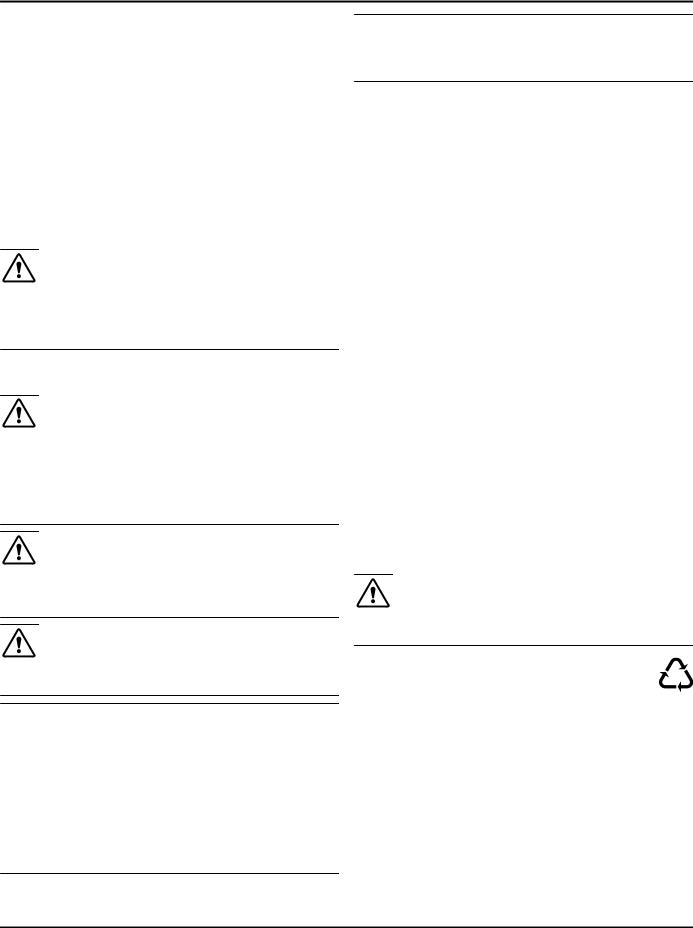
Start-up
– after switch-on the temperature is not yet cold enough
– the temperature has risen by several degrees Dashes are shown on the display:
– the freezer temperature is above 32 °F (0 °C).
The following displays indicate malfunction. Possible causes and corrective actions are to be found in the Troubleshooting section.
–nA
–F0 bis F5
4 Start-up
4.1 Transporting the appliance
CAUTION
Risk of injury or damage if incorrectly transported. u Transport the appliance in its packaging.
u Transport the appliance upright:
u Do not move the appliance on your own:
4.2 Setting up the appliance
WARNING
Risk of fire due to moisture!
If live parts or the power cord get wet, this can cause a short circuit.
u The appliance is designed for use in enclosed spaces. Do not operate the appliance in open space or in damp areas or where there is spray.
WARNING
Danger of fire and damage!
u Do not place devices that give off heat, e.g. microwaves, toasters, etc. on the appliance.
CAUTION
Risk of personal injury!
u Have two people move this appliance into place.
NOTICE
Risk of damage caused by condensation
Installing the appliance next to any other refrigerator or freezer can cause damage or condensation to the Liebherr appliance.
u Do not install this appliance next to any other refrigerator or freezer except another Liebherr model. Liebherr models are designed to allow side-by-side installation. They are equipped with a heating system to eliminate condensation when refrigerators or freezers are installed side- by-side.
NOTICE
Risk of damage for the finished floor surface!
u Protect the finished floor surface before you uncrate the unit.
Verify that:
q the floor under the appliance is flat and level.
qthe floor can support the appliance's weight plus approximately 1200 pounds (544 kg) of food weight.
qthe appliance is not placed in direct sunlight or near the stove, range top, radiators and similar heat sources.
qthe kitchen cabinet that the appliance is installed in is shimmed to the floor level if the floor heights are not equal.
qcutout dimensions are accurate.
qelectrical outlet is in correct location.
qthe air flow is not restricted. Air flow must be provided for the appliance to operate properly. The factory air vents provide 31 square inches (200 cm2) of air flow per appliance. If you are replacing the air vents with an overlay, the air flow must be the same or greater than the factory air vents.
u Examine the unit and packaging for shipping damage. Contact the carrier immediately if you suspect there is any damage.
u Note the type (model, number), index, appliance/serial number, date of purchase and where purchased on the spaces provided in see Appliance Information.
u Remove anything attached to the rear or side walls of appliance that would prevent proper installation or impede proper ventilation.
If the appliance is set up in humid areas, condensation may build on the outside of the appliance.
u Always ensure proper ventilation.
4.3 Disposal of packaging
WARNING
Danger of suffocation from packaging materials and films! u Do not allow children to play with packaging materials.
The packaging is made from recyclable materials:
– Corrugated card/cardboard
– Preformed pieces from foamed polystyrene
– Films and bags from polyethylene
– Packing bands from polypropylene
u Take the packaging material to an official collection point.
5
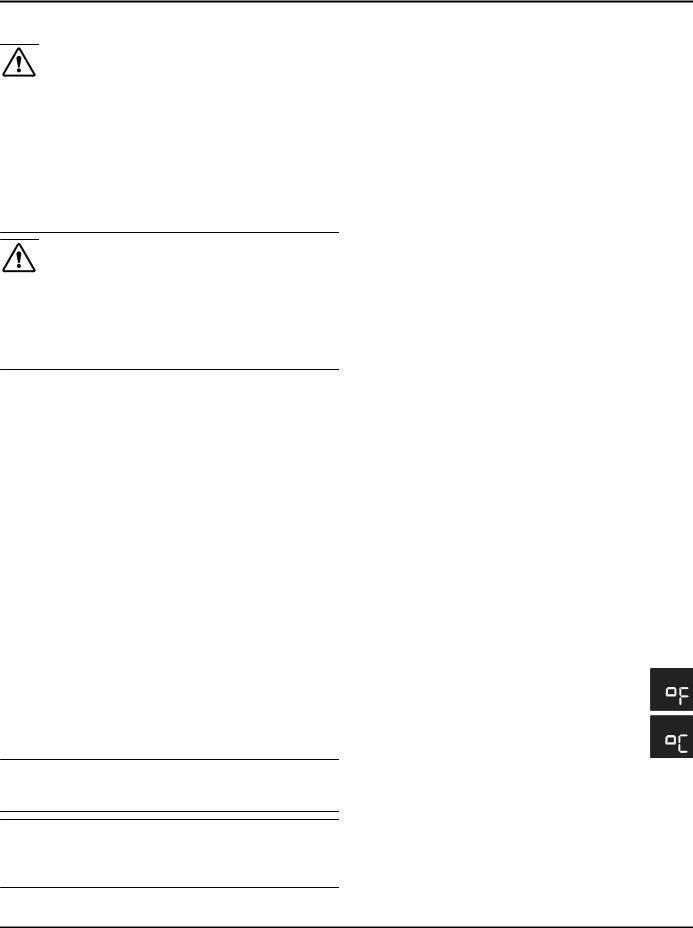
Operation
4.4 Connecting the appliance
WARNING
Electrical shock hazard!
u Start-up should only take place once the appliance has been installed according to these instructions.
u Electrically ground appliance. u Do not ground to a gas pipe.
u Check with a qualified electrician if you are not sure the appliance is properly grounded.
u Do not have a fuse in the neutral or grounding circuit. u Do not use an extension cord or a multiple socket. u Do not use a power cord that is frayed or damaged.
WARNING
Electrical shock hazard!
This appliance is equipped with a three-prong (grounding) polarized plug for your protection against possible shock hazards. Electrical Grounding Required.
u Do not remove the round grounding prong from the plug. u Do not use a two-prong grounding adapter.
–Wait 30 minutes up to 1 hour after installation before you plug in the appliance. This allows the refrigerant and system lubrication to reach equilibrium.
–Make sure incoming voltage is the same as the appliance rating. A 110-120 Volt, 60 Hz, 15 Amp electrical supply (20 Amp for side-by-side installations) circuit that is controlled by a circuit breaker or fuse is required.
–We recommend using a dedicated circuit for this appliance to prevent electrical overload.
–Follow all Federal, State and local electrical, fire and building codes and ordinances when installing the receptacle and / or the appliance.
–In some communities, a wall switch is required to turn power to the appliance ON and OFF.
–To reduce the risk of fire, electric shock, or personal injury, installation work and electrical wiring must be done by a qualified electrician in accordance with all applicable codes and standards, including fire-rated construction.
–You are advised to clean the appliance before switching it on the first time (see Cleaning).
–The top of the electric outlet must be located within 82-5/8 in. (2100 mm) from the top of the base in the cabinet.
4.5 Switching on the appliance
Note
u To switch on the entire appliance, only the freezer compartment needs to be switched on.
Note
u Once the appliance is switched on, first the freezer compartment is cooled and then, 2-3 hours later, the fridge compartment.
Put the appliance into operation about 2 hours before loading with frozen food for the first time.
Do not load frozen foods until the temperature display reads 0 °F (-18 °C).
4.5.1 Switching on the freezer compartment
u PressOn/Off button, freezer compartment Fig. 2 (3).
w The refrigerator compartment temperature display indicates the set temperature.
w The freezer compartment temperature display and the alarm button flash until the temperature is sufficiently cold. If the temperature is above 32 °F (0 °C), dashes flash. If it is below, the current temperature flashes.
4.5.2 Switching on the fridge compartment
u Press Fridge compartment On/Off button Fig. 2 (11). w The interior light comes on when the door is opened.
w The temperature display flashes. The fridge compartment is switched on.
5 Operation
5.1 Energy saving
u Always ensure good ventilation to and from the appliance!
u Avoid opening the appliance door for any longer then neccesary.
u Store food logically.
u Storing hot food: let it cool to room temperature first. u Defrost frozen food in the fridge.
5.2 Temperature display unit
The temperature display can be changed from °F to °C.
5.2.1 To change the unit
u Activate |
setting |
mode: Press SuperFrost button |
||
Fig. 2 (2) for about 5 seconds. |
|
|
||
w The SuperFrost button Fig. 2 (2) will flash. |
||||
w c is displayed in the temperature display. |
||||
u Using |
Freezer |
compartment |
Up |
button |
Fig. 2 (5)/ Freezer compartment Down button |
||||
Fig. 2 (4) select °. |
|
|
button |
|
u To confirm: Briefly press SuperFrost |
||||
Fig. 2 (2). |
compartment |
Up |
button |
|
u Using |
Freezer |
|||
Fig. 2 (5)/ Freezer compartment Down button |
||||
Fig. 2 (4) select °F or °C. |
|
button |
||
u To confirm: Briefly press SuperFrost |
||||
Fig. 2 (2). |
|
|
|
|
u To exit setting mode: Press Freezer compartment On/Off button Fig. 2 (3).
-or-
u Wait 5 minutes.
w The temperature is again displayed in the temperature display.
6
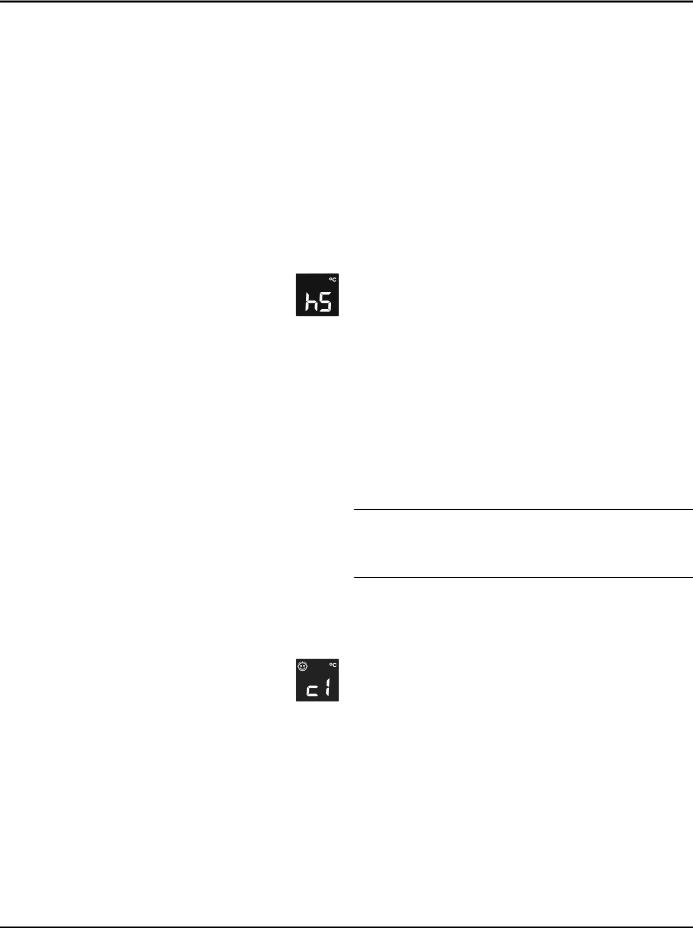
Operation
5.3 Brightness of the temperature display
You can adapt the brightness of the temperature display to the light conditions in the room in which it is installed.
5.3.1 Setting the brightness
The brightness can be set between h1 (minimum luminosity) and h5 (maximum luminosity).
u To activate setting mode: Press SuperFrost button Fig. 2 (2) for about 5 seconds.
w c is shown on the display.
w The SuperFrost button will flash.
u Press Freezer compartment Up button Fig.2 (5) or Freezer compartment Down button to select Fig. 2 (4)h.
u To confirm: Briefly press SuperFrost button Fig. 2 (2). u To set the display brighter: Press Freezer com-
partment Up button Fig. 2 (5).
u To set the display darker: Press Freezer compartment Down button Fig. 2 (4).
u To confirm: Press SuperFrost button Fig. 2 (2). w The brightness is set to the new value.
u To deactivate setting mode: Press Freezer compartment On/Off button Fig. 2 (3).
-or-
u Wait 5 minutes.
w The temperature is again displayed in the temperature display.
5.4 Child-proof lock
You can use the child-proof lock to lock the buttons. This means that children cannot accidentally switch off the appliance when playing.
5.4.1 Switching on the child-proof lock
u To activate setting mode: Press SuperFrost button Fig. 2 (2) for about 5 seconds.
w c is shown on the display.
w The SuperFrost button will flash.
u Press the SuperFrost button Fig. 2 (2) briefly to confirm. u To switch on: Using Freezer compartment Up
button Fig. 2 (5) or Freezer compartment Down button Fig. 2 (4) select c1.
u To switch off: Using Freezer compartment Up button Fig. 2 (5) or Freezer compartment Down button Fig. 2 (4) select c0.
u To confirm: Press SuperFrost button Fig. 2 (2).
w If the Child-proof lock symbol Fig.2 (8) lights up, the childproof lock is switched on.
u To deactivate setting mode: Press Freezer compartment On/Off button Fig. 2 (3).
-or-
u Wait for 5 minutes.
w The temperature is again displayed in the temperature display.
5.5 Door alarm
If the door is open for longer than 180 seconds, the acoustic warning sounds.
The acoustic warning stops automatically when the door is closed.
5.5.1 Switching off the door alarm
The acoustic warning can be switched off when the door is open. The acoustic warning remains switched off as long as the door is open. When the door is closed, the alarm function is active again.
u Press Alarm button Fig. 2 (1). w The door alarm stops.
5.6 Temperature alarm
If the freezer temperature is not cold enough, the acoustic warning sounds.
At the same time the temperature display will flash. The cause of the temperature being too high may be:
–hot fresh food was placed in the appliance
–when sorting and removing food from the appliance, too much warm ambient air got in
–the power was cut off for a while
–the appliance is experiencing difficulties
The acoustic warning automatically ceases and the temperature display stops flashing when the temperature is cold enough again.
If the alarm status remains, proceed according to the Faults section.
Note
If the temperature is not cold enough, food may spoil.
u Check the quality of the food. Do not consume spoiled food.
5.6.1 Switching off the temperature alarm
The acoustic warning can be switched off. When the temperature is cold enough again, the alarm function is active again.
u Press Alarm button Fig. 2 (1). w The acoustic warning ceases.
5.7 Fridge compartment
The natural circulation of air in the fridge compartment results in zones with differing temperatures. It is coldest directly above the vegetable drawers and at the rear wall. It is warmest at the top front of the compartment and in the door.
7
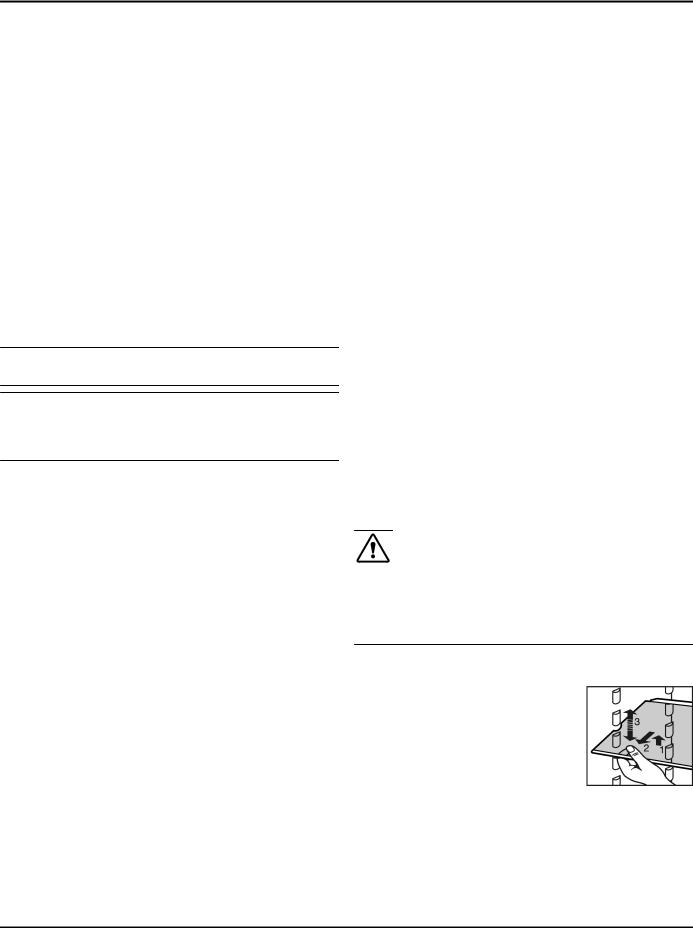
Operation
5.7.1 Arranging Food
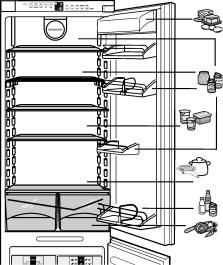 Fig. 3
Fig. 3
5.7.2 Refrigerating food
Note
u Do not load the door with more than 35 lbs (16 kg) of food.
Note
Insufficient ventilation results in an increase in energy consumption and reduction of the refrigerating performance. u Never block the air slits in the fan.
u Use recyclable plastic, metal, aluminum and glass containers and cling film to wrap foods.
u Always use closed containers for liquids and for food that may give off or be tainted by odor or flavor transfer, or cover them.
u Foods which give off a large amount of ethylene gas and those that are sensitive to this gas, such as fruit, vegetables and salad, should always be separated or wrapped so as not to reduce the storage life; e.g. do not storage tomatoes together with kiwi fruits or cabbage.
u Use the front floor area of the fridge compartment only to temporarily to set down food to be refrigerated, e. g. when rearranging or sorting the contents of the fridge. Do not leave the food there, as it may be pushed back or tipped over when the door is closed.
u Do not store food too close together to enable good air circulation.
u To ensure bottles do not tip over: move the bottle holder.
5.7.3 Setting the temperature in the fridge compartment
The temperature can be set from 46 °F (7 °C) to (2 °C), (5 °C) is recommended.
u To set a higher temperature: Press Fridge compartment Up button Fig. 2 (10).
u To set a lower temperature: Press Fridge compartment Down button Fig. 2 (9).
wWhen the button is pressed for the first time, the previous value is indicated in the fridge compartment temperature display.
To change the temperature in 1 °F (1 °C) steps: briefly press the button.
To change the temperature continuously: Hold button down.
The value is displayed flashing during the setting operation.
The actual temperature is displayed about 5 seconds after the last press of a button. The temperature slowly
adjusts to the new value.uuww
5.7.4 SuperCool
With SuperCool you switch to the highest cooling performance to reach lower cooling temperatures. Use SuperCool to rapidly cool large quantities of food.
SuperCool will use more energy than normal operation.
Cooling with SuperCool
u Briefly press the SuperCool button Fig. 2 (12). w The SuperCool button Fig. 2 (12) lights up.
w The cooling temperature drops to the coldest value. SuperCool is switched on.
w SuperCool automatically switches itself off after about 6 hours. The appliance returns to work in the energy-sav- ing normal mode.
To prematurely switch off SuperCool
u Briefly press the SuperCool button Fig. 2 (12). w The SuperCool button Fig. 2 (12) goes out.
w SuperCool is switched off.
5.7.5 Repositioning the shelves
CAUTION
Danger of lacerations!
The storage shelf can shatter if dropped or mishandled. You could cut yourself on the pieces of broken glass.
u Only remove storage shelves when there is nothing on them.
Extension stops secure the shelves against being accidentally pulled out.
u Lift the shelf and pull out forward.
u Insert the shelf with the raised edge to the back pointing upwards.
w This prevents food from contacting and freezing to the back wall.
8
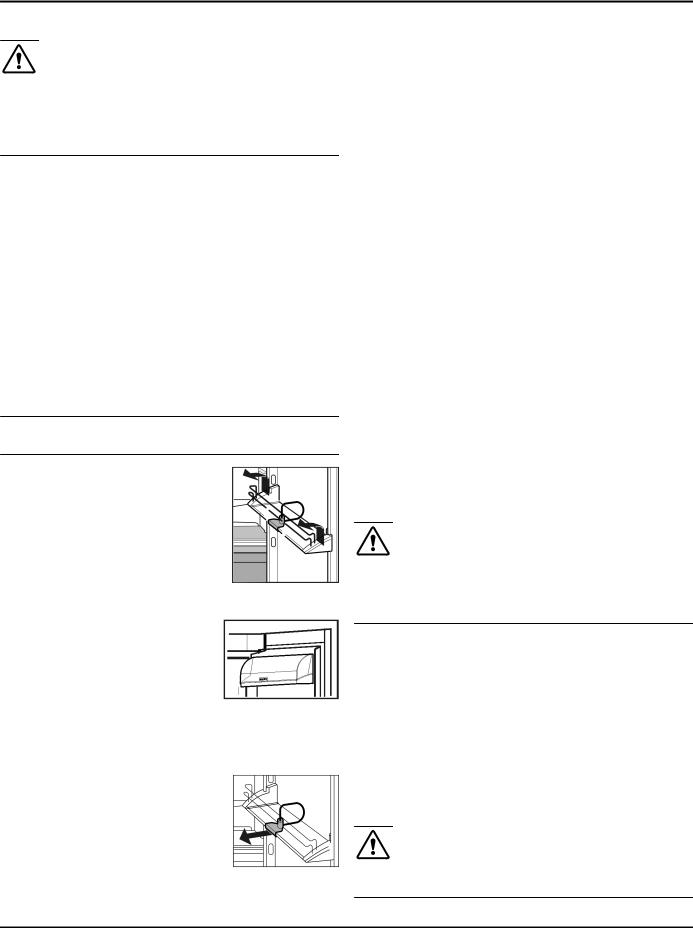
Operation
5.7.6 Using the split shelf
CAUTION
Danger of lacerations!
The storage shelf can shatter if dropped or mishandled. You could cut yourself on the pieces of broken glass.
u Only remove storage shelves when there is nothing on them.
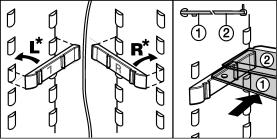 Fig. 4 u Attach support bars supplied, ensuring right (R) and left
Fig. 4 u Attach support bars supplied, ensuring right (R) and left
(L) parts are correctly positioned.*
u The glass plate with raised edge (2) must be positioned at the back.
u To clean, remove the support bars for the half glass plate.
5.7.7 Repositioning the door racks
Note
u Do not load the door with more than 35 lbs (16 kg) of food.
u Push rack up, pull forward and reinsert in the reverse order.
Always take the butter and cheese compartment out together with the cover.
u To remove the cover: Press one side of the butter and cheese compartment outwards until the hinge pin of the cover is released, then remove the cover sideways.
5.7.8 Removing the bottle holder
u Remove the bottle holder as per the illustration.
u Always take hold of the bottle holder by the plastic part.
5.7.9 Fan
The fan allows you to rapidly cool large amounts of fresh food or to achieve a relatively even distribution of temperature across all the storage levels.
Re-circulated air cooling is advisable:
–at high room temperatures (from approx. 95 °F (35 °C) )
–in the case of high humidity
Re-circulated air cooling has a somewhat higher energy consumption. To save energy, the fan automatically switches off when the door is open.
Switching on the fan
u Briefly press Ventilation button Fig. 2 (13). w The Ventilation button lights up.
w The fan is switched on.
Switching the fan off (default)
u Briefly press Ventilation button Fig. 2 (13). w The Ventilation button lights up.
w The fan is switched off.
5.8 Freezer compartment
You can store frozen food, make ice cubes and freeze fresh food in the freezer compartment.
5.8.1 Freezing food
The maximum load for each drawer and the plate is 55.12 lbs (25 kg) of frozen food.
After the door is closed, a vacuum is created. After closing the door, wait about 1 minute, then the door is easier to open.
CAUTION
There is a risk of injury from pieces of broken glass. Bottles and cans containing drinks can split or crack when frozen. This applies in particular to carbonated drinks.
u Do not freeze bottles and cans containing drinks.
So that the food is rapidly frozen through to the core, do not exceed the following quantities per pack:
– fruit, vegetables up to 2.2 lb (1 kg)
– meat up to 5.51 lbs (2.5 kg)
u Pack the food in portions in freezer bags, reusable plastic, metal or aluminum containers.
5.8.2 Defrosting food
–in the fridge compartment
–at room temperature
–in the microwave
–in the oven/fan oven
WARNING
Danger of food poisoning!
u Do not re-freeze defrosted food.
9
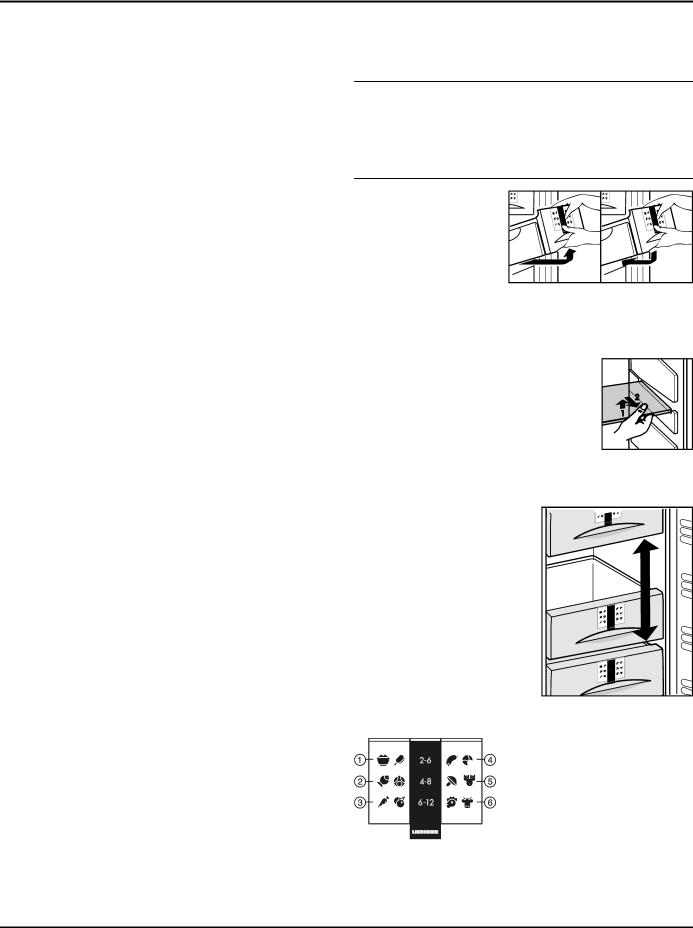
Operation
u Only take out the amount of food that is required. Use defrosted food as quickly as possible.
w The appliance returns to work in the energy-saving normal mode.
5.8.3 Setting the temperature in the freezer compartment
The appliance is set as standard for normal operation.
The temperature can be set between 8 °F (-14 °C) and -14 °F (-26 °C), 0 °F (-18 °C)is recommended.
u To set a higher temperature: Press Freezer compartment Up button Fig. 2 (5).
u To set a lower temperature: Press Freezer compartment Down button Fig. 2 (4).
w When the button is pressed for the first time, the previous value is indicated in the freezer compartment temperature display.
u To change the temperature in 1 °F (1 °C) steps: briefly press the button.
-or-
u To change the temperature continuously: hold the button down.
w The value is displayed flashing during the setting operation.
w The actual temperature is displayed about 5 seconds after the last press of a button. The temperature slowly adjusts to the new value.
5.8.4 SuperFrost
With this function you can rapidly freeze fresh food through to the core. The appliance works with maximum refrigerating performance. The sound of the refrigeration unit may be temporarily louder as a result.
The maximum number of kilograms of fresh food that can be frozen within a 24-hour period is indicated on the rating plate under "Freezing capacity ... kg/24h". This maximum amount of frozen food varies according to the model and climate rating.
Freezing with SuperFrost
You do not need to switch SuperFrost on in the following cases:
–when placing frozen food in the freezer
–when freezing up to about 2 kg of fresh food daily u Briefly press the SuperFrost button Fig. 2 (2) once. w The SuperFrost button Fig. 2 (2) lights up.
w The freezer temperature drops, the appliance works with maximum refrigerating capacity.
When a small amount of food is to be frozen: u Wait for about 6 hours.
u Place the fresh food in the top drawers.
When the maximum amount of food is to be frozen: u Wait for about 24 hours.
u Place wrapped food directly on the shelves and place in the drawers once frozen.
w SuperFrost is automatically switched off. At the earliest after 30 hours, at the latest after 65 hours, depending on the quantity placed inside the appliance.
w The SuperFrost button Fig. 2 (2) is dark.
5.8.5 Drawers
Note
Insufficient ventilation results in an increase in energy consumption and reduction of the refrigerating performance. For appliances with NoFrost:
u Leave the bottom drawer in the appliance.
u Never block the air slits in the fan on the rear wall.
u To store frozen food directly on the shelves: pull the drawer forward and lift it out.
5.8.6 Shelves
u To remove shelf: lift it at the front and pull out forward.
u To reinsert shelf: simply slide it in as far as it will go.
5.8.7 VarioSpace
In addition to the drawers, you can also take out the shelves. This gives you space for large frozen items. Poultry, meat, large joints of game and tall bakery items can be frozen and then presented whole.
u The maximum load for each drawer and the plate is 55.12 lbs (25 kg) of frozen food.
5.8.8 Info system
(1) |
Ready meals, ice |
Fig. 5 |
Sausages, bread |
(4) |
|||
(2) |
cream |
(5) |
Game, mushrooms |
Pork, fish |
|||
(3) |
Fruit, vegetables |
(6) |
Poultry, beef/veal |
10

Maintenance
The numbers indicate the storage time in months for different types of frozen foods. The storage times given are guidelines.
5.8.9 IceMaker*
The IceMaker is in the top drawer of the freezer compartment. The drawer is labeled "IceMaker".
Make sure that the following conditions are fulfilled:
–The appliance is level.
–The appliance is connected to the electricity supply.
–The freezer compartment is switched on.
–The minimum freezer temperature is 14 °F (-10 °C).
–The IceMaker is connected to the water supply.
Switching on the IceMaker*
u Pull out the drawer.
Fig. 6
u Press On/Off button Fig. 6 (1) so that the LED Fig. 6 (2) lights up.
u Push in the drawer.
Note
u The IceMaker only produces ice cubes when the drawer is completely closed.
Switching off the IceMaker*
If ice cubes are not required, the IceMaker can be switched off independently of the freezer compartment.
When the IceMaker is not in operation, clean the IceMaker. This ensures that no water or ice remains in the IceMaker.
When the IceMaker is switched off, the drawer of the IceMaker can also be used for freezing and storing food.
u Press the On/Off button for about 1 second until the LED goes out.
Producing ice cubes*
The production capacity depends on the freezer temperature. The lower the temperature, the more ice cubes can be produced in a certain period.
The ice cubes fall out of the IceMaker into the drawer. When the ice cubes reach a certain height in the drawer, no more ice cubes can be produced.
If large quantities of ice cubes are required, the complete IceMaker drawer can be swapped with the neighboring drawer. When you close the drawer, the IceMaker automatically restarts production.
When the IceMaker is switched on for the first time, it may take up to 24 hours for the first ice cubes to be produced.
Note
u Do not consume or use the first three batches of ice cubes. This applies both to using the appliance for the first time and using it when it has not been used for a long time. This ensures that the water pipe is rinsed through.
6 Maintenance
6.1 Defrosting with NoFrost
The NoFrost system defrosts the appliance automatically.
Fridge compartment:
The defrosted water is evaporated by the heat of the compressor. Drops of water on the back wall are a functional feature and completely normal.
u Clean the drain opening regularly so that the defrosted water can flow away. (see Cleaning section).
Freezer compartment:
The moisture condenses on the evaporator and is periodically defrosted and evaporated.
u The appliance does not have to be defrosted manually.
6.2 Cleaning the appliance
Before cleaning:
WARNING
Danger of electric shock.
u First, remove the plug or switch off the fuse.
CAUTION
Risk of injury or damage due to hot steam.
Hot steam can damage the surfaces and cause burns. u Do not use steam cleaners.
NOTICE
Incorrect cleaning damages the appliance. u Do not use concentrated cleaning agents.
u Do not use steel wool or sponges that scour or scratch. u Do not use cleaning agents containing sand, chloride,
chemicals or acids.
u Do not use chemical solvents.
u Do not damage or remove the rating plate on the inside of the appliance. It is vital for the customer service department.
u Do not pull off, kink or damage any cables or other components.
u Do not let cleaning water get into the drain gutter, the ventilation grille and electrical parts.
u Empty the appliance.
–Use soft cleaning cloths and a multi-purpose cleaning agent with a neutral pH value.
–Only use food-compatible cleaning and care agents inside the appliance.
11
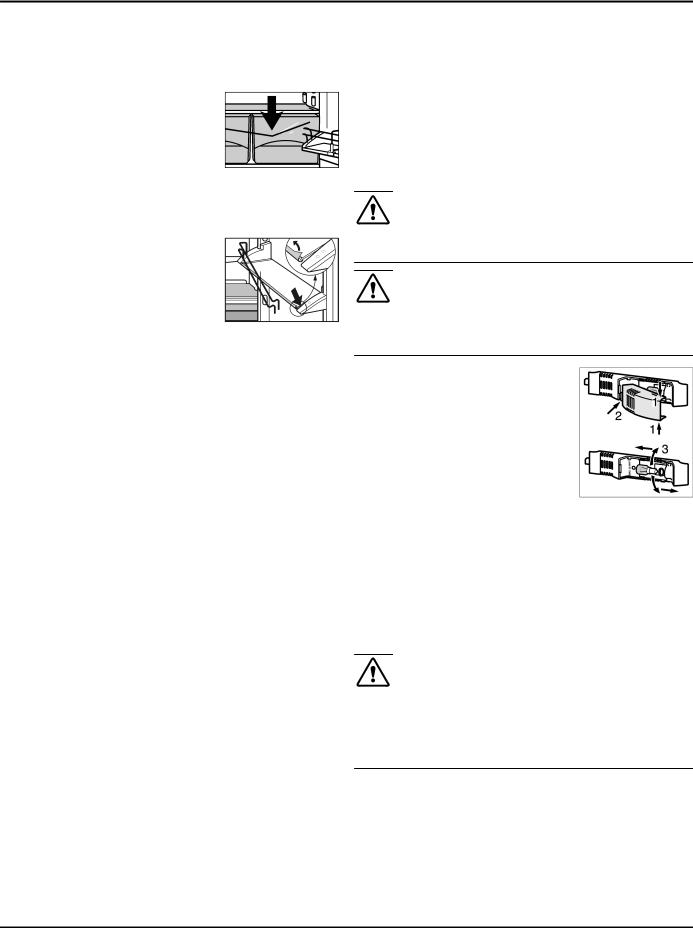
Maintenance
Exterior surfaces and interior:
u Clean the ventilation grilles regularly.
w Dust deposits increase energy consumption.
u Clean the plastic surfaces, outside and inside, by hand using lukewarm water and a little dish washing liquid.
u To clean the drain opening: remove deposits with a thin instrument, e.g. a cotton bud.
Items of equipment:
u Clean the roller plates in the dishwasher.
u Clean other items of equipment by hand using lukewarm water and a little dish washing liquid.
u To dismantle shelves: remove trims and side parts.
u To dismantle door racks: remove protective films from the trims.
After cleaning:
u Wipe dry the appliance and items of equipment. u Connect the appliance and switch it on again.
u Switch on SuperFrost. (see section on SuperFrost) When the temperature is sufficiently cold:
u Put the food back in the appliance.
6.3 Cleaning the IceMaker*
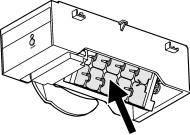 Fig. 7
Fig. 7
The IceMaker must be switched on.
u Pull out the drawer and take out the ice.
u Clean the drawer with warm water and mild dish washing liquid.
u With the drawer pulled out, press and hold the On/Off button (for about 10 seconds).
w After about 1 second the LED goes out, the IceMaker is switched off.
w After about 10 seconds the LED flashes for about 60 seconds.
u Push the drawer in while the LED is flashing. w The ice tray of the IceMaker rotates and tilts. u Take out the drawer.
u Clean the ice tray with warm water. If necessary, use a mild dish washing liquid. Then rinse.
To switch the IceMaker on again:
u Press the ON/OFF button until the LED lights up, then push the drawer in.
w The IceMaker starts to produce ice cubes. If dish washing liquid was used:
uThrow out the first three batches of ice cubes to get rid of any dish washing liquid residues.
6.4 Replacing the interior light*
Light bulb data
q max. 25 W (25 W) q 120 V
q Bulb fitting: E14
q Current and voltage must agree with the details on the rating plate.
WARNING
Danger of electric shock.
u First, remove the plug or switch off the fuse.
CAUTION
Cutting hazard!
u To prevent possible injury due to broken glass, use hand protection when replacing the interior light.
u Take hold of the light cover at the |
|
top and bottom Fig. 8 (1). |
|
u Unclip light cover at the back |
|
and unhook Fig. 8 (2). |
|
u Replace the light bulb Fig. 8 (3). |
|
When turning it, use a little more |
|
force to overcome the static friction |
|
of the seal. Make sure the seal sits |
|
cleanly in the light socket. |
Fig. 8 |
u Hook the cover in again at the |
|
back and clip in at the sides. |
|
6.5 Customer service
First check whether you can remedy the fault yourself using the summary in the Troubleschooting section. If this is not the case, please contact the Customer Service department. You can find the address in the enclosed customer service list.
WARNING
Risk of injury from repairs by non-professionals.
u Repairs and work on the appliance and the power cord, which are not expressly named in the Maintenance section should only be carried out by the customer service department.
12
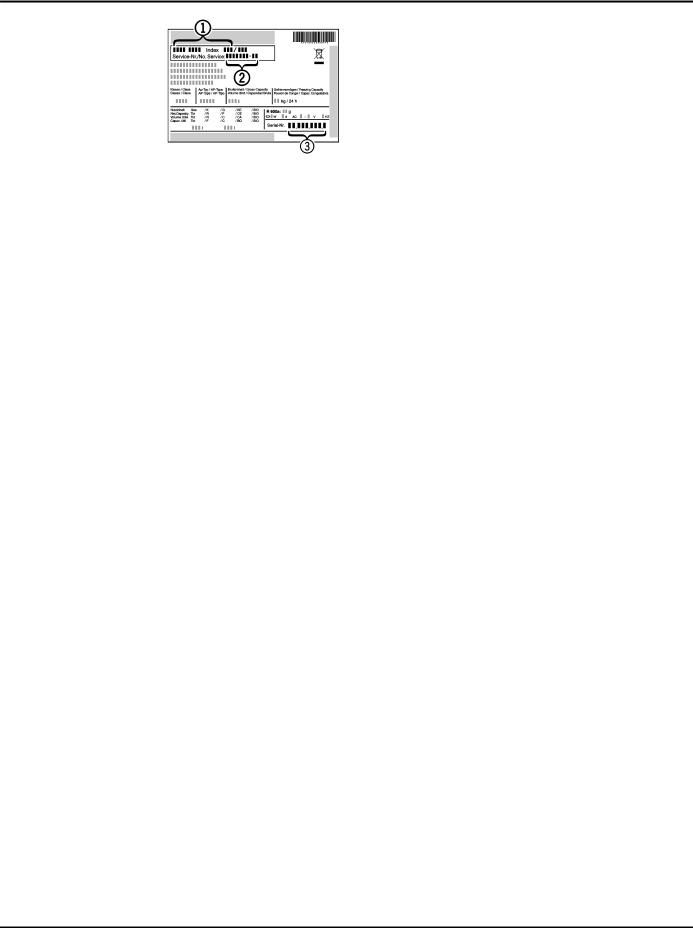
Troubleshooting
u Read the appliance designation Fig. 9 (1), service no. Fig. 9 (2) and serial no. Fig. 9 (3) from the rating plate. The rating plate is located inside the appliance on the left-hand side.
Fig. 9 u Notify the Customer Service department, specifying the fault, appliance designation Fig. 9 (1), service no.
Fig. 9 (2) and serial Fig. 9 (3) no.
w This will help us to provide you with a faster and more accurate service.
u Keep the appliance closed until the Customer Service engineer arrives.
w The food will stay cool longer.
u Disconnect the power plug (do not pull on the power cord to do this) or switch off the fuse.
Type Designation: |
_____________________ |
Service Number: |
_____________________ |
Appliance / Serial Number: |
_____________________ |
Date of purchase: |
_____________________ |
Where purchased: |
_____________________ |
7 Troubleshooting
Your appliance is designed and manufactured for reliable operation and a long lifespan. If a malfunction nonetheless occurs during operation, please determine if the malfunction is due to an operating error. If a service call determines operator error, you will be charged for the costs incurred, even during the warranty period. You may be able to rectify the following problems yourself:
6.6 Appliance Information
Make a note of this information when the appliance is installed:
Problem |
Possible Cause |
Correction |
||
The appliance |
→ |
The appliance is not switched on. |
u Switch on the appliance. |
|
does not work. |
→ |
The power plug is not properly in- |
u Check the power plug. |
|
|
|
serted in the wall socket. |
|
|
|
→ |
The fuse in the wall socket is not |
u Check the fuse. |
|
|
|
OK. |
|
|
|
→ |
Power failure |
u Keep the appliance closed. |
|
|
|
|
u Protect the food: place dry ice on top of the food or use |
|
|
|
|
|
a use a decentral freezer, if the power failure persists |
|
|
|
|
for some time. |
|
|
|
u Do not re-freeze defrosted food. |
|
The compressor |
→ |
When less refrigeration is required, |
u |
This is normal in energy-saving models. |
|
||||
runs for a long |
|
the speed-controlled compressor |
|
|
time. |
|
switches to a low speed. Although |
|
|
|
|
the running time is increased as a |
|
|
|
|
result, energy is saved. |
|
|
|
→ |
SuperFrost function is activated. |
u The compressor runs long to rapidly cool food. This is |
|
|
|
|
|
normal. |
|
→ |
SuperCool function is activated. |
u The compressor runs long to rapidly cool food. This is |
|
|
|
|
|
normal. |
A gurgling sound |
→ |
This sound comes from the refrig- |
u |
The sound is normal. |
|
||||
|
|
erant flowing in the refrigeration cir- |
|
|
|
|
cuit. |
|
|
A faint clicking |
→ |
The sound always occurs when the |
u |
The sound is normal. |
|
||||
sound |
|
refrigeration unit (the motor) auto- |
|
|
|
|
matically switches on or off. |
|
|
13

Troubleshooting
Problem |
Possible Cause |
|
|
Correction |
|||
A hum. It is brief- |
→ |
The refrigeration increases auto- |
u |
The sound is normal. |
|||
ly a little louder |
|
matically |
when |
the |
SuperFrost |
|
|
when the refrig- |
|
function is activated, fresh food |
|
|
|||
eration unit (the |
|
has just been placed in the appli- |
|
|
|||
motor) switches |
|
ance or the door has been left open |
|
|
|||
on. |
|
for a while. |
|
|
|
|
|
|
→ |
The refrigeration increases auto- |
u The sound is normal. |
||||
|
|
matically |
when |
the |
SuperCool |
|
|
|
|
function is activated, fresh food |
|
|
|||
|
|
has just been placed in the appli- |
|
|
|||
|
|
ance or the door has been left open |
|
|
|||
|
|
for a while. |
|
|
|
|
|
|
→ |
The ambient temperature is too |
u See section Range of appliance use |
||||
|
|
high. |
|
|
|
|
|
A low hum |
→ |
The sound occurs as a result of fan |
u |
The sound is normal. |
|||
|
|
air flow. |
|
|
|
|
|
The temperature |
→ |
There is a fault. |
|
|
u Contact the customer care department. See Mainte- |
||
display indi- |
|
|
|
|
|
|
nance section. |
cates: F0 to F5 |
|
|
|
|
|
|
|
The temperature |
→ |
The freezer temperature rose too |
u Press the Alarm button Fig. 2 (1). |
||||
display indi- |
|
high during the last hours or days |
w Thewarmest temperature reached during the power |
||||
cates: nA |
|
due to power failure or power inter- |
|
failure is displayed in the temperature display for about |
|||
|
|
ruption. When the power interrup- |
|
60 seconds. Then the electronics again indicate the |
|||
|
|
tion is over, the appliance will |
|
current freezer temperature. |
|||
|
|
continue to operate at the last tem- |
u To delete the display of the warmest temperature |
||||
|
|
perature setting. |
|
|
|
ahead of time: Press the Alarm button Fig. 2 (1). |
|
|
|
|
|
|
|
u Check the quality of the food. Do not consume spoiled |
|
|
|
|
|
|
|
|
food. Do not re-freeze defrosted food. |
The outside sur- |
→ |
The heat of the refrigerant circuit is |
u |
This is normal. |
|||
faces of the ap- |
|
used to prevent condensate from |
|
|
|||
pliance are |
|
forming. |
|
|
|
|
|
warm. |
|
|
|
|
|
|
|
The IceMaker |
→ |
The appliance and therefore the |
u |
Connect the appliance. See also section on connect- |
|||
cannot be |
|
IceMaker are not connected. |
|
ing the appliance) |
|||
switched on.* |
|
|
|
|
|
|
|
The IceMaker is |
→ |
The IceMaker is not switched on. |
u Switch the IceMaker on. |
||||
not making ice |
→ |
The drawer of the IceMaker is not |
u Close the drawer properly. |
||||
cubes.* |
|
properly closed. |
|
|
|
|
|
|
→ |
The water connection is not open. |
u Open the water connection. |
||||
The temperature |
→ |
This means that the door of the ap- |
u |
Close the appliance door. |
|||
is not cold |
|
pliance is not closed properly. |
|
|
|||
enough. |
|
|
|
|
|||
→ |
Insufficient ventilation. |
|
u Clear ventilation grilles. |
||||
|
→ |
The ambient temperature is too |
u See Range of appliance usesection. |
||||
|
|
high. |
|
|
|
|
|
|
→ |
The appliance was opened too fre- |
u Wait to see whether the required temperature resets |
||||
|
|
quently or for too long. |
|
|
itself by itself. If not, contact the customer service de- |
||
|
|
|
|
|
|
|
partment See Maintenance section. |
14
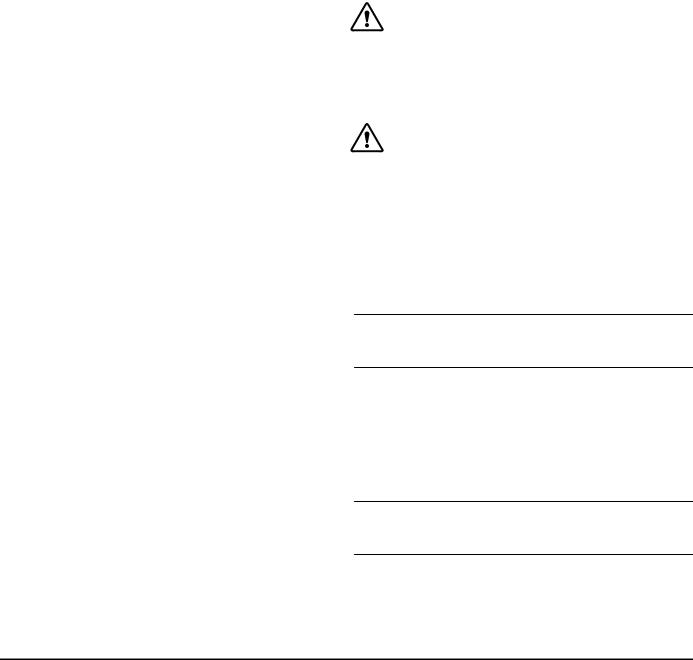
|
|
|
|
Putting appliance out of service |
|
|
|
|
|
|
|
Problem |
Possible Cause |
Correction |
|
||
|
→ |
Too much fresh food was placed |
u See SuperFrost section. |
|
|
|
|
inside without SuperFrost. |
|
|
|
|
→ |
The temperature is incorrectly set. |
u Set to a colder temperature and check after 24 hours. |
|
|
|
→ The appliance is too near to a heat |
u See Installation section. |
|
||
|
|
source. |
|
|
|
The interior light |
→ |
The appliance is not switched on. |
u Switch on the appliance. |
|
|
is not on. |
→ |
The door was open for longer than |
u The interior light automatically switches itself off if the |
|
|
|
|
15 minutes. |
|
door has been open for about 15 minutes. |
|
|
→ If the interior light is not on but the |
u Replace the bulb according to the Maintenance sec- |
|
||
|
|
temperature display is lit, the bulb |
|
tion.* |
|
|
|
is faulty.* |
|
|
|
|
→ The LED interior light is faulty or the |
|
|
|
|
|
|
|
|
||
|
|
cover is damaged.* |
|
WARNING* |
|
|
|
|
Risk of injury from electrical shock. |
|
|
|
|
|
Live parts are under the cover. |
|
|
|
|
|
u The LED interior light should only be replaced or re- |
|
|
|
|
|
|
paired by the Customer Service department or by en- |
|
|
|
|
|
gineers trained to do so. |
|
|
|
|
|
|
|
|
|
|
|
WARNING* |
|
|
|
|
Risk of injury from class 1M laser radiation. |
|
|
|
|
|
u Do not look inside when the cover is open. |
|
|
|
|
|
|
|
|
|
→ The LED freezer compartment light |
u You can replace the light unit yourself. The replace- |
|
||
|
|
is not on.* |
|
ment part is available from the customer service de- |
|
|
|
|
|
partment. See Maintenance section.* |
|
8 Putting appliance out of service
8.1 Vacation Tips
Short vacations: If you will be away for less than four weeks
u Use all perishables. u Freeze other items.
u Turn off the refrigerator compartment. u Turn off the icemaker.*
u Shut down the water supply to the icemaker.*
Long vacations: If you will be away for a month or more u Remove all food from the appliance.
u Turn OFF the appliance.
u Clean the appliance. Refer to section on "Cleaning" u Leave the door open to prevent unpleasant odors. w This will also keep mold from building up.
u Turn of the icemaker.*
u Shut off the water supply to the icemaker.*
8.2 Switching off the appliance
Note
u To switch off the entire appliance, only the freezer compartment needs to be switched off.
8.2.1 Switching off the freezer compartment
u Press Freezer compartment On/Off button Fig. 2 (3) for about 2 seconds.
w The temperature displays are dark. The appliance is switched off.
8.2.2 Switching off the fridge compartment
Note
u The fridge compartment can be switched off independently of the freezer.
u Press Fridge compartment On/Off button Fig. 2 (11) for about 2 seconds.
w The fridge compartment temperature display Fig. 2 (7) is dark. The fridge compartment is switched off.
15
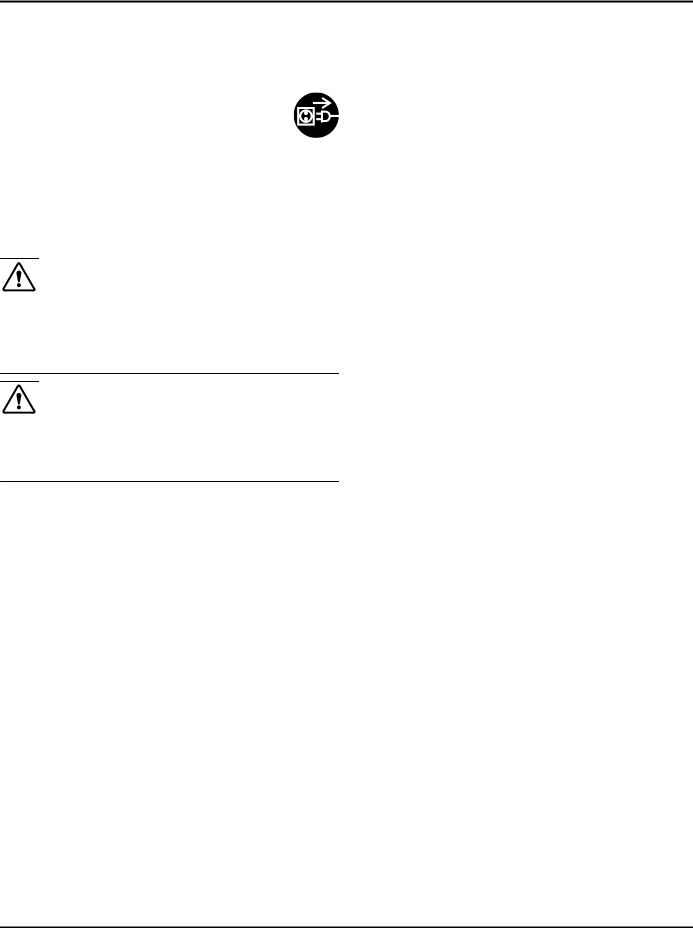
Disposing of the appliance
8.3 Decommissioning
u Empty the appliance.
u Put the IceMaker in the cleaning position. (see section on cleaning IceMaker)*
u Disconnect the power plug.
u Clean the appliance (see section on cleaning). u Leave the door open to prevent bad smells.
9 Disposing of the appliance
Follow the local regulations for the disposal of appliances. Old appliances can be dangerous. Contact the local refuse collection department for additional information.
DANGER
There is a risk of suffocation.
Children playing can shut themselves in and suffocate. u Take the door(s) off.
u Leave the storage shelves in the appliance so that children cannot easily climb into the appliance.
WARNING
Danger of electric shock.
u Cut off the plug from the mains cable and discard.
u Cut off the mains cable from the discarded appliance. Dispose of separately from the appliance.
10 Liebherr Warranty Plan
FULL TWO YEAR WARRANTY - For two years from the date of original purchase, your Liebherr warranty covers all parts and labor to repair or replace any part of the product which proves to be defective in materials or workmanship.
FULL FIVE YEAR WARRANTY - For five years from the date of original purchase, your Liebherr warranty covers all parts and labor to repair or replace any components that prove to be defective in materials or workmanship in the sealed system. The “Sealed System” means only the compressor, condenser, evaporator, drier and all connecting tubing.
LIMITED 6TH THROUGH 12TH YEAR WARRANTY -
From the 6th through 12th year from the date of original purchase, your Liebherr warranty covers all parts that prove to be defective in materials or workmanship in the Sealed System (parts only).
TERMS APPLICABLE TO EACH WARRANTY
All service provided by Liebherr under the warranty must be performed by authorized Liebherr service representatives, unless otherwise specified by Liebherr. Service will be provided in the home during normal business hours. This warranty applies only to products installed for normal residential use. Details regarding a non-residential warranty are available on request.
The warranty applies only to products installed in any one of the fifty states of the United States or the District of Columbia. The warranty does not cover any parts or labor to correct any defect caused by negligence, accident or improper use, maintenance, installation, service or repair, including but not limited to improper removal and reinstallation of the condensing unit.
The remedies described above for each warranty are the only ones which Liebherr will provide, either under these warranties or under any warranty arising by operation of law. Liebherr will not be responsible for any consequential or incidental damages arising from the breach of these warranties or any other warranties, whether express, implied or statutory.
Some states do not allow the exclusion or limitation of incidental or consequential damages so the above limitation or exclusion may not apply to you. This warranty gives you specific legal rights and you may also have other legal rights which very from state to state.
To receive parts and/or service and the name of the Liebherr authorized service representative nearest you, contact your Liebherr dealer or distributor or contact the Liebherr designated national service provider:
in the US: Liebherr@adcoservice.com or call 1- 866 - LIEBHERR ( 1- 866 - 543-2437).
in Canada: www.euro-parts.ca or call 1-888-LIEBHERR (1-888-543-2437).
16
